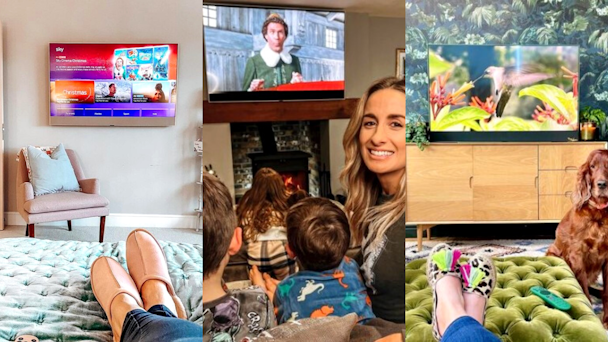How influencer marketing was the surprise winner of Sky Glass’s revolutionary roll-out
A year after it first announced its dish-less TV, we sit down with Sky’s marketing director, Sunny Bhurji, to find out how its biggest-ever product marketing campaign is going.

It took 18 ”hardcore months” to bring the Glass launch campaign to life
Sky Glass was designed to future-proof the British broadcaster. Its streaming gambit simplifies its offering, bundling together its TV packages with a dish-less 4K screen, voice tech and an inbuilt sound bar, all for a single monthly payment. It also promised to help customers navigate the intimidating scale and complexity of the TV space – something that rivals are clearly still trying to crack.
A year on from its unveiling, Sky Glass is now in ”hundreds of thousands” of homes, says marketing director Sunny Bhurji. He is ”really delighted with the performance” of the launch campaign, which has run across pretty much every conceivable platform. The surprise winner, however, was influencer marketing, which he says will now be an integral part of promotional plans going forward.
Advertisement
The launch
Last year, Bhurji told The Drum how it took 18 ”hardcore months” to bring the Glass launch campaign to life. The first weeks focused on showcasing the device and its features, and generally raising awareness. Then, eight TVCs directed by Michael Gracey (best known for much-loved film The Greatest Showman, but also for Evian’s celebrated ’Roller Babies’) were released in bursts. The ads showed how Glass empowers a family, almost like magic, with each focusing on a different product benefit.
The launch film was one of the most-watched on The Drum this past year.
Sky claims that 95% of UK adults saw the full campaign, which it says doubled awareness of Sky Glass. On launch, Bhurji estimated about 55% of marketing spend was going to above the line, while 45% went into digital, on everything from PPC display (and retargeting), all the way through to YouTube, Spotify, Facebook, Instagram and WeTransfer takeovers.
Despite all the initial research, however, the campaign had to pivot a few months in. ”When we started to actually get some responses, what we realized was that people didn’t quite understand that we’d made a TV with all your Sky magic inside. This was a brand-new category. It wasn’t another set-top box and it wasn’t just a TV.”
The multi-million-pound campaign was altered to better articulate this and what was initially a comms bullet point was elevated to be a topline message. ”We pivoted into what we’d probably call more kind of rational product advertising.”
Advertisement
There are a lot of good TVs on the market, but Sky rationalizes that what it is selling is curation and ease – it has been programming TV software for decades, well before TVs became smart. ”We probably slightly underestimated how much of a category we were creating. We had so many things to communicate and we had to find ways to connect with our customers at different points in their journeys.”
But the surprise big hitter, he says, was the influencer marketing component of the campaign. It was Sky’s biggest-ever coordinated influencer campaign, featuring 182 influencers with a combined 97 million followers on Instagram and YouTube. Across more than 2,500+ pieces of content, it engaged with some 1.7 million people and generated some 300,000 clicks to the Sky landing page where they could learn more about the product.
Suggested newsletters for you
”This was a new area for Sky. And so, actually, what we realized during the campaign was the power of influencers. It helped us really see how people understand the product and find new ways to see how it benefits customers.
”The totality of putting our influences together and launching at the same time, but also keeping that drumbeat from launch all the way up to now, has really helped us dive deep while also focusing on different areas.”
Each influencer niche had its own selling point to drive, which helped Sky to refine its messages in a more authentic manner that would land with real people. Family-orientated influencers talked up convenience while interior designers talked up aesthetics, he explains.
”It’s one thing writing a product feature as a blurb on a website or putting it in an image, but having that real shareable content puts you in the heart of what’s going on.”
It ”smashed it” with regards to engagements, sharing and driving understanding, with Bhurji promising it will ”absolutely be the bedrock” of all its plans moving forward.
These plans include year two of Sky Glass marketing as well as the promotion of its recently released set-top box Sky Stream, a next-gen product that again operates without the need to install a dish – the Sky Glass product minus the TV, basically.
Following the success of this campaign, influencers were baked into Sky’s wider 2022 plans across Twitter, Facebook and Instagram. It has also just partnered with some 50 ambassadors on TikTok.
Bhurji is talking to The Drum one day before a big ad shoot with a broad swathe of influencer and celeb types. He teases: ”We’re going to do something slightly different with this one.”
To listen to our full conversation with Sky’s Sunny Bhurji, check out The Drum’s TV Talks podcast.

